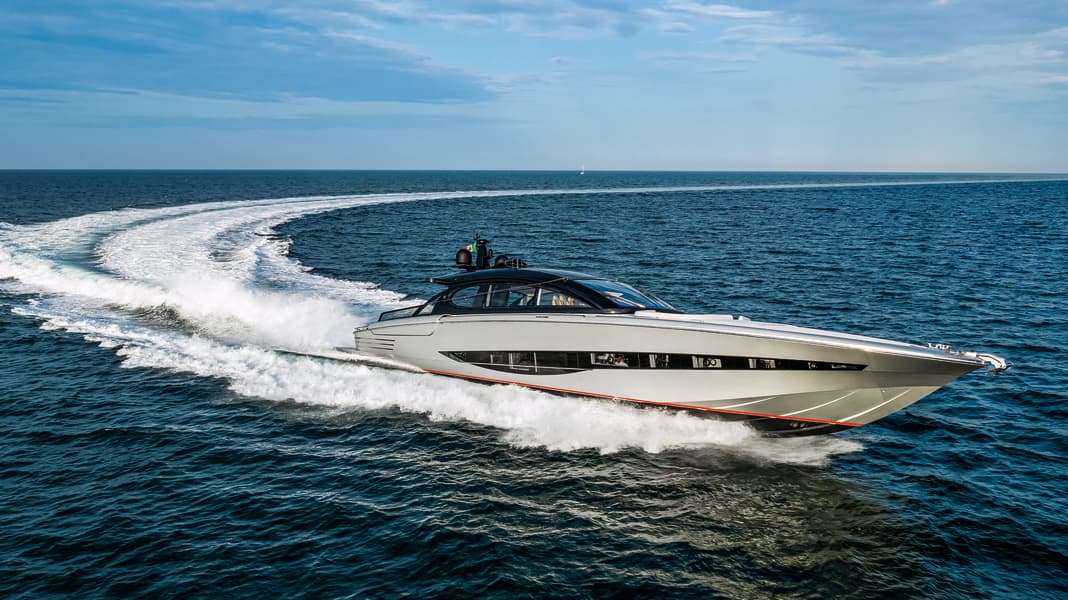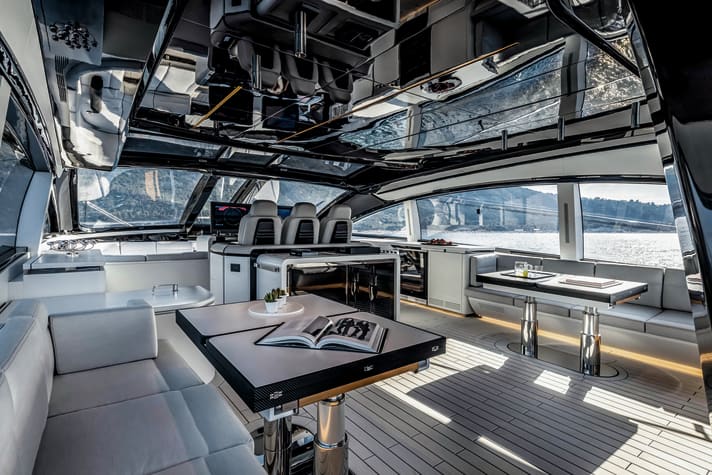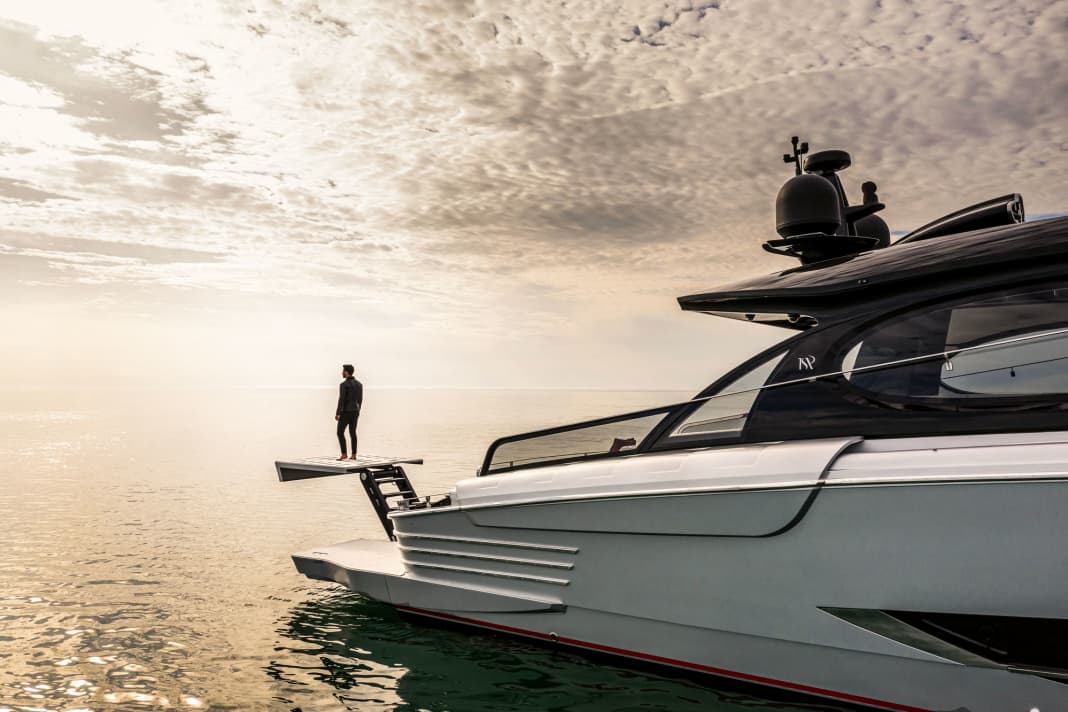
When Marco Casali talks about his work and his designs, it just bubbles out of him. Listening to the likeable designer talk enthusiastically is a real pleasure. It is pure euphoria that drives the yacht-obsessed Roman and makes him gesticulate in typical Italian fashion as he talks about his creative ideas. With his Studio Too Design, he has long been an ally of major brands such as Bavaria and Itama, for which he has designed numerous models and played a key role in shaping their image. When the Palumbo Group took over the ISA Yachts shipyard a few years ago, its managing director Giuseppe Palumbo dreamed of honouring and reinventing the well-known brand's bestseller - the ISA Sport 120. "That's how our work on the ISA Super Sportivo 100 GTO began," recalls Marco Casali. "I presented Sig. Palumbo one of my concepts and he was thrilled - that was the starting signal!" The shipyard engaged Studio Arnaboldi, based in Viareggio, to design the sporty deep-V hull lines.
"Sports yachts are now a niche within a niche"
"Sports yachts designed for high speeds are now clearly a niche in the superyacht market, which is a niche in itself," explains Casali. But they still exist, the customers who are longing for just such a format. "I am currently talking to five potential buyers who are interested in a 'Super Sportivo' that is to be built to their specifications," reveals the designer. The owner of "Aldabra", the first unit, also had very specific ideas. The layout of the 85-tonne carbon and GRP laminate boat has five cabins and two compartments for a maximum crew of four. This is unusual for a slim glider with a length of 29.60 metres, and the individual suites are correspondingly small. Anyone who assumes from the sporty appearance that "Aldabra" will be used as a dayboat or at most as a weekender is obviously mistaken. "'Aldabra' is used extensively around her berth in Sardinia," says Marco Casali.
Another special request is best felt with bare feet. "Aldabra" dispenses with teak decking and instead flatters the toes with Seadek, a soft material that is usually used on stand-up paddle boards or windsurfing boards. "The coolest material currently available on the market," enthuses the designer. "Super soft, easy to clean and many times lighter than teak or synthetic teak." The owner insisted on the new deck material, a stroke of luck for ISA Yachts. "We need courageous and innovative owners who push us to go in a direction we wouldn't go without them," says Palumbo Group Marketing Director Virginia de Carlo. "This is the only way we can continue to develop."

The salon surprises with a loft-like openness
In addition to the rather nested room layout on the lower deck, the main deck surprises with a contrasting utilisation of the available space. In the centre of the loft-like open saloon, a helm station is "enthroned", deliberately reminiscent of the command bridge of the Starship Enterprise. "I always wanted to design a Star Trek-style bridge - that was my dream," says a delighted Marco Casali at the sight of the two large-format Furuno displays, which have been elegantly installed on a seemingly free-floating carbon pedestal and provide the captain with all the important on-board information. Aft, two elongated sofas with height-adjustable tables face each other, while six "Donald" chairs from Poltrona Frau complete the area to create a cosy dinner ensemble if required.
The aft cockpit is completely taken up by an XL sunbathing area, where five sun-seekers can comfortably indulge in idleness side by side. A few steps behind, at the transom, the shipyard has created a comfortable bench seat for up to four people, where you can develop a special feeling for the high cruising speeds of the "Aldabra". "A high-speed experience up close, so to speak," comments Marco Casali. A tender up to four metres long can be stored in the rear garage and is lowered into the water via the bathing platform using a sled system.

As there are no side decks, the only way onto the open foredeck is through the saloon and a jumbo-sized double door. "A huge Portuguese bridge awaits the owner and his guests at the front - never before seen on a sports yacht," says Casali. This front cockpit, which is recessed into the deck and therefore sheltered, consists of two U-shaped sofas, with a further sunbathing area for sun-seekers on the deck in front.
"Aldabra" was three tonnes lighter than calculated
As is to be expected when building a sports yacht, a strict diet regime was on the construction plan for the first Super Sportivo 100 GTO. The shipyard in Ancona wet-laminated the hull from GRP with carbon fibre reinforcements, while the deck was made entirely from high-strength black fibre fabrics. "Normally, prototypes are heavier than the designers' predictions," explains de Carlo. "With 'Aldabra', we were three tonnes lighter!" To accelerate the 29.60 metre glider to its top speed, three MAN twelve-cylinder engines transfer their power of 1490 kilowatts each to two waterjet drives plus a booster jet. "'Aldabra' is a powerhouse, without a doubt," confirms Marco Casali. In order to supply the engines with sufficient fresh and cool air, the Too design team created air inlets of the type normally used on Formula 1 racing cars or offshore racing boats. The two ventilation openings are located in the centre in front of the flat antenna mast and ensure that 30 percent more air reaches the engine compartment, allowing the powerful MAN engines to deliver more power in the long term.
And the fuel consumption? Counter-question from the smiling designer: "Do you also ask how much your Ferrari consumes?" The Super Sportivo burns less fuel than its competitors for one simple reason: it is significantly lighter. This allows it to reach the same speed with smaller engines.
So, what is it like travelling at 55 knots on "Aldabra"? "It feels fantastic, but you don't feel the speed," explains Marco Casali convincingly. "Thanks to the jet propulsion, there are no vibrations, and the sharply cut deep-V hull ploughs the sea smoothly and calmly, even in larger swells."






"Aldabra" has the most beautiful bays for itself
In times when owners want to get more and more living space and room out of their yachts, this uncompromising hull shape is definitely a characteristic feature. "The Super Sportivo 100 GTO is not a bulky 'SUV' or a glass 'house on the sea', it is quite clearly a sports yacht. We have designed her in such a way that she can leave any harbour without any problems even in winds of more than two forces and still deliver her performance. To be honest, not even force five winds are a problem. But then the vast majority of yachts stay in the marina - which is fantastic, as 'Aldabra' then has the most beautiful bays to herself," comments the Roman designer with satisfaction.

Technical data
- Length over everything: 29,60 m
- Waterline length: 23,80 m
- Width: 6,83 m
- Depth: 1,35 m
- Displacement: 85 t
- Material: GRP, carbon fibre
- Motors: 3 x MAN V12 2000
- Engine power: 3 x 1490 kW
- Waterjets:3 x MJP 500
- Speed (max.):55 kn
- Speed (travelling):44 kn
- Range at 12 knots: 550 nm
- Consumption at 44 kn: 20 l/sm, 880 l
- Consumption at 55 kn:21.8 l/sm, 1200 l
- Fuel:13500 l
- Generators:2 x Kohler 28 kW
- Stabiliser: Seakeeper 35
- Construction:Studio Arnaboldi
- Exterior design: Marco Casali/Too Design
- Interior design: Marco Casali/Too Design
- Shipyard:ISA Yachts, 2021
This article first appeared in our sister magazine BOOTE-Exclusive

